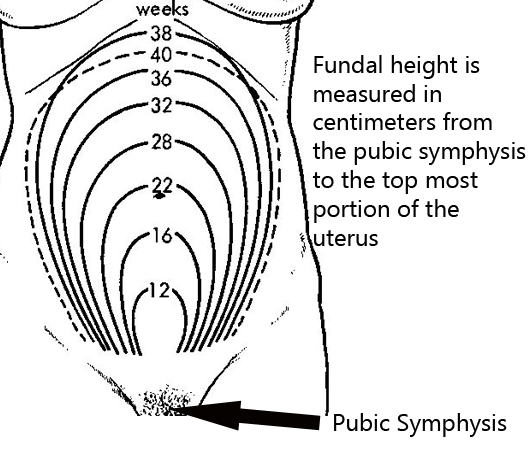Prenatal Cytogenetic Testing
The goal of all prenatal testing is to determine if there are any abnormalities in the developing fetus. Not all pregnancies are "candidates" for certain forms of prenatal testing. Determining whether or not to perform invasive testing depends on many factors. Some of the common indications for invasive prenatal cytogenetic testing include:
(1) Advanced maternal age; mother will be greater than or equal to 35 years of age at time of delivery.
(2) Previous child with a genetic abnormality, especially if mother is greater than 30 years old.
(3) Known parental chromosomal abnormalities.
MSAFP
The first test that is often ordered is the maternal serum α-fetoprotein (MSAFP). The MSAFP is typically ordered between 15 and 20 weeks gestation. AFP is produced by the fetus. It crosses the placenta into the maternal blood stream where it can be measured. MSAFP can be normal, elevated, or decreased.
Elevated levels of MSAFP occur for many different reasons. Some are pathological, others are not. It is associated with neural tube defects (ie: spina bifida, anencephaly, etc.), gastrointestinal and abdominal wall problems (ie: gastroschisis, omphalocele), multiple gestations (ie: twins, triplets, etc.), fetal death, placental problems, as well as underestimated gestational age.
Depressed levels of MSAFP are harbingers of chromosomal abnormalities. The most common one is trisomy 21 (Down’s syndrome). In addition, trisomy 18 (Edward’s syndrome) is also associated with low levels of MSAFP.
Quad Screen
If abnormalities in MSAFP are detected additional maternal blood markers are measured. This is referred to as the "quad screen".
The quad screen consists of MSAFP, estriol, inhibin-A, and beta-HCG. The levels of these molecules taken together provide greater sensitivity in diagnosing chromosomal abnormalities in the fetus. For example:
| Fetal Abnormality: | Quad Screen Results: |
|---|---|
| Trisomy 21 (aka: Down’s Syndrome) | – Decreased AFP and estriol – Increased β-HCG and inhibin |
| Trisomy 18 (aka: Edward’s Syndrome) | – Decreased AFP, estriol, inhibin, and β-HCG |
An abnormality in any of these markers is not 100% diagnostic of fetal pathology. In order to confirm the fetal diagnosis more invasive tests can be performed. These include amniocentesis and chorionic villus sampling.
Amniocentesis
Amniocentesis collects amniotic fluid surrounding the developing fetus. Amniotic fluid contains fetal cells that can be sent for genetic analysis. It is typically done around 15 to 17 weeks of gestation.
The procedure involves using a needle to withdraw the fluid. This is done either through the abdomen or cervix. Since amniocentesis is an invasive test there are risks. Miscarriage can occur in up to 0.5% of cases; in addition, bleeding (either maternal or fetal) can also occur.
| Indications for amniocentesis | Advanced maternal age (>35 years old) at time of delivery. |
| If quad screen was abnormal. | |
| In cases where maternal-fetal blood incompatibility is an issue (ie: Rh-sensitization). | |
| In cases where premature delivery may occur. Amniocentesis can be done to help determine the maturity of the fetal lungs. |
Chorionic Villus Sampling
Chorionic villus sampling is another invasive test that can be used to diagnose fetal chormosomal abnormalities. It is typically done between 10 and 12 weeks of gestation. It involves sampling a piece of the chorion, which is a component of the placenta. Its main advantage is that it can be done earlier than amniocentesis; however, there is a slightly increased risk of fetal death. In addition, the diagnostic accuracy is not quite as great as amniocentesis in picking up neural tube defects.
Peripheral Umbilical Blood Sampling
Peripheral umbilical blood sampling is a process in which the fetal umbilical blood vessels are punctured so that fetal red blood cells can be obtained for analysis. This procedure is typically done in the 2nd or 3rd trimesters when there is a possibility of fetal hemolytic disease. Hemolytic diseases of the newborn occur when the mother produces antibodies that attack fetal red blood cells.
Related Articles
References and Resources
- Wagner B, Meirowitz N, Shah J, et al. Comprehensive Perinatal Safety Initiative to Reduce Adverse Obstetric Events. J Healthc Qual. 2011 Mar 1.
- Whitworth M, Bricker L, Neilson JP, et al. Ultrasound for fetal assessment in early pregnancy. Cochrane Database Syst Rev. 2010 Apr 14;(4):CD007058.
- Beckmann CRB, Ling FW, Smith RP, et al. Obstetrics and Gynecology
. Fifth Edition. Philadelphia: Lippincott Williams and Wilkins, 2006.
- Bickley LS, Szilagyi PG. Bates’ Guide to Physical Examination and History Taking
. Ninth Edition. New York: Lippincott Williams and Wilkins, 2007.

